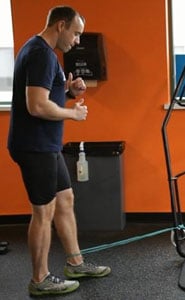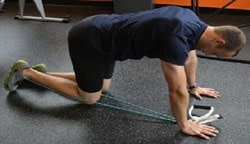It seems like every year there is a new aspect of running we need to work on
One year it was our feet; foot core was the secret to injury free running.
Another year it was overstriding and a low cadence that was preventing us from running faster.
But all of these have one prerequisite; we must learn how to engage glutes when running to run faster and more efficiently.
We know the core (hips, transverse abdominis, lower back) are important for preventing running injuries, but without exercises to strengthen your hips, glutes and hamstrings, your body will break down.
How to strengthen your hips and glutes effectively was even one of the five steps outlined by Brad Beer to stay injury free for life.
Today we’re going to change gears from injury-prevention and focus on performance improvement.
Specifically, we’re going to look at the role of the hamstrings, hips and glutes during the running stride and how they generate the power to propel you forward. If you need to diagnose weak/stiff hip flexors and glutes, this will also help you do that.
If you are looking for the best glute exercises, you are in the right place.
We just want you to use those firm glutes and strong hip muscles to help you run faster with every step, not look good in a pair of yoga pants….although that may be an extra benefit of doing the right exercises to strengthen them!
Ready to work? Let’s go!

Why are Hips, Glutes, and Hamstrings So Important for Running?
One very common mistake, or perhaps misconception, about how to run is exactly where the “power” in your stride comes from.
Most people picture power being generated in the running stride when the foot pushes off the ground, which is correct.
But in the mental image that most people carry with them, that “push” comes from the quads, much like a leg press, or the calves.
Here’s the deal:
While it’s true that some of the power in the running stride comes from your quads and calves, the reality is that the quads and calves play only a minor role in your ability to generate a powerful stride compared to the hips, hamstrings and glutes.
The power these three muscle groups generate and the biomechanical process is called hip extension.
Therefore, understanding exactly how hip extension works, being able to visualize the process, and then identifying ways to improve is essential.
What is hip extension?
Hip extension is the act of driving your entire upper thigh (and leg for that matter) backwards after your foot contacts the ground.
Now:
The power for this movement is generated primarily from the hip extensor muscles, glutes, and hamstring and it is perhaps the single most important factor in your ability to run faster.
Hip extension begins as your foot contacts the ground (ideally directly under your center of mass) and continues as you pull the leg beneath you and ends right before you push off with your ankle.
When we try to improve hip extension, we generally focus on two areas:
1. The degree to which you apply force as the leg contacts the ground and you drive it behind the body, often called the drive phase of hip extension.
2. How far behind you the leg travels – the amount or angle of extension.
The drive phase is a combination of how powerfully you contract and engage your hip extensors, glutes and hamstring to pull the leg under and behind you as you touch the ground.
The more powerful your hip extension, the faster you will go.
The drive phase of hip extension is brief and shouldn’t be confused with forcing the leg backwards
Once you’ve initiated hip drive and generated power through the hip, you should relax and let the leg travel behind you naturally.
What’s the bottom line?
The distance or degree to which your leg travels behind you will be in direct correlation to how much force you generate during the drive phase.
Therefore, there is no reason to force the leg backwards – it will happen naturally.
Recovery phase
After you’ve driven your leg back, the stretch-reflex of the hip flexors kicks in and begins to propel your leg forward.
A common misconception about the role of the hamstrings during this phase of the running gait is that they should contract to bring the heel closer to the butt (which occurs to shorten the lever as the leg swings forward).
Remember this:
Bringing the heel towards the butt actually requires very little activation of the hamstring.
Electrographic research suggests it is as little as 7%.
The movement of the heel towards the butt is aided by the stretch-reflex generated during hip extension.
This is why the faster you run, the closer your heel will get to your butt without trying to.
Wasting energy actively bringing the heel towards the butt by contracting the hamstring is inefficient.
How to Strengthen your Hip extensor Muscles, Glutes and Hamstrings as a Runner
Now that we understand how the biomechanics of hip drive work, we can better target our stretching, drills and strength work to improve exactly how these muscles function during the running stride.
Here are some stretches, drills and exercises to get you started:
1. Theraband drive back x 20-25 with each leg


With your foot or heel attached to a cable machine, stand facing the structure that the cable is attached to.
Balance on one foot (it’s ok to hold onto another object for balance) and bring your leg slightly in front of you. Drive backwards with your foot in the band.
Focus on generating the movement from your glutes and hamstrings. Slowly bring the leg back up and repeat.
2. Single leg glute bridge (use stability ball for added difficulty) x 15-20 with each leg


Lie flat on your back with one leg bent, foot flat on a stability ball, and the other leg flat on the ground.
Slowly lift your pelvis off the ground by contracting your glutes and core while keeping your shoulder blades flat on the ground.
3. Donkey kicks with theraband x 15-20 with each leg


Start on all fours. Insert a theraband so one end is wrapped around your knee and the other the bottom of your foot.
Extend your leg back and up, focusing on contracting with your glutes.
4. Straight leg bounds x 100 meters

Run forward by keeping your legs straight and driving through the ground with your hips and glutes. Begin by running 50 meters.
Progress until you’re running 100 meters.
5. Two-Joint Hip Flexor Stretch – Repeat 8 to 10 times


Lie flat on your back on a table or elevated surface (a bed works) with your legs just off the edge. Bring both your knees to your chest.
Scoop both hands under one leg and then let the other leg drop down below the edge of the table or surface.
Let your leg drop as far as you can while holding the other leg to your chest with your hands.
These 5 exercises will help get you started on improving your hip extension and developing flexibility to generate more power from your stride.
RunnersConnect Bonus
Download your FREE Improvement Performance Calculator now.
This handy pace calculator helps you to determine what pace you should be running at in training and at each racing distance based on a recent race result.
If you’re interested in additional exercises and learning more about how to improve your own running form, check out our personalized video form analysis and 6-week online course.
The course includes an individual, slow-motion video analysis of your form and specific and progressive set of stretches, strength routines and drills to help improve your mechanics.





9 Responses
Just want to say thank for telling me something I never knew I had to do like exercing not just running never knew that speed that a runner gets comes from the cluets,hips and thights thats why I could never pass other runners without getting tired and fatueged but now that I know I have to genarate power from the hips and clutes I believe with patience and training I will get faster.
Great post! Thanks for sharing your valuable and very informative exercises to get fast running. I tried the donkey kick exercise before but never tried other exercises and will do these exercises as well. 🙂
Thank you so much, glad you enjoyed it. Keep them up, you will see the difference 🙂 Thanks for the feedback! You should check out our podcast with Matt Phillips, you would enjoy it by the sounds of it. https://runnersconnect.net/rc43
Interesting! I recently came across a trainer who told me I wasn’t engaging my glutes and hamstrings when I run. It was obvious he was right, my glutes and hams never hurt but my Lord- my calves and quads were inflamed to the high heavens.
He showed me some exercises to engange the glutes and hams. After about of week and a half of intense focus on those muscles, I kid you not- just by knowing how to get those muscles working, I literally improved my pace by an average of 25 seconds (until they wear out-but I’m working on that!).
This is great advice for us new runners especially!
Hi Stephanie, thanks for sharing. Glad to hear you had such a big improvement from the exercises, we wish more runners would see the importance and make the changes! Share this with your friends, all we want is to help runners improve 🙂 Keep up the good work!
Thank you for such an informative article. The role of the glute, hamstring and hip flexors now makes perfect sense andI’m able to visualise these muscles working in sync. I can feel those all important areas getting stronger, my pelvis more stable and my running form improving overall. best of all, niggling injuries (due to poor running form) have disappeared. Many thanks
Thank you Deborah, glad we were able to help. That is what we pride ourselves on; being the site with the real information that makes sense! Hope this helps, and please let us know if we can help with anything else. Best of luck!
I recently tore my calf muscle after significantly increasing distance and hill work over few months. The injury seemed to be without warning — I’d never felt fatigue or soreness in my calves after a hard workout. But I had been suffering from soreness and stiffness in my hamstrings and glutes all the time. It seems clear to me now, after reading this article, that my calf injury was caused by relative weakness in my hamstrings and glutes, which put excess strain on my calves as they compensated. I now know my rehab has to include work to strengthen these key muscle groups. Thank you!
Hello Coach Jeff,
First of all thanks for such a valuable piece of information. Just to let you know I have been running for past 40+ years and more. Had given up training the hamstring since I cannot bend my knees due to the ACL surgery and my glutes will never get engaged nor I can use my hips to generate power or the drive thro’. So instead focused heavily on quads and calves to run pain free. But alas every time my hips will shut down completely. My PT always kept saying I have to use my glutes to run and I should feel my hamstring.
I am never sold by a single sensible advice so much. I am going to single mindedly devout myself in strengthening my hips, glutes and hip extensors and will post my progress.
Thank you so much for making this so simpler that people like me can understand it.